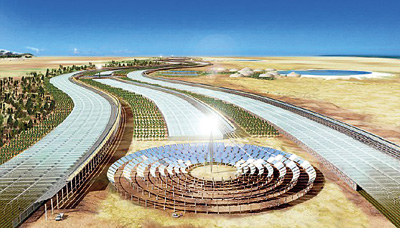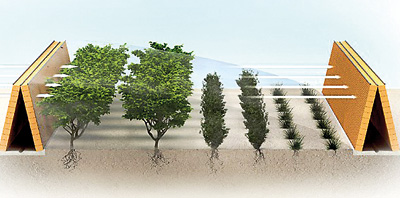Scientists inspired by a camel's nostrils are set to achieve the impossible and grow a man-made forest in the desert.
The £3.3 million giant open-air greenhouse in Qatar will bring plantlife to one of the most inhospitable spots on earth and it is all thanks to the humped mammal's nose.
 |
| Pioneering: The sweeping giant greenhouse will be in Qatar and will sustain all sorts of plantlife including trees |
 |
| Smart: This graphic shows how evaporative hedges will provide humidity and shelter for plants growing there |
 |
| Incredible: It is the camel's sophisticated nostrils that allow it to stay alive in intense heat |
Using a trick of nature the Sahara Forest Project will use surface water and cold water pumped up from 200 metres below the sand to feed trees, vegetables and algae.
The irrigation system will work in the same way as a camel's nostrils by constantly condensing water that the heat evaporates during the day.
As the animal breaths out moist air, its nose instantly sucks it in and condenses any water, keeping it alive in the harsh desert. Its nostrils also suck in water from the warm humid night air to keep it hydrated.
Inspired by this, designers say their 10,000 square metre project will use a similar idea, which they have already tested successfully.
Using solar power they will pump water throughout the giant glass structure.
The hot desert air will evaporate surface water that appears overnight but strategically placed hedges will cool it before it escapes into the sky, keeping the greenhouse at an ideal temperature for growth.
As this cooler moist air created by the hedges flows around the site it will hit the cold pipes containing water pumped from deep below the sand, instantly condensing again.
This will then provide a constant source of moisture to feed and grow all the plants there.
'The Pilot Project in Qatar will demonstrate the benefits of reducing waste streams in technological systems. Our message is that it is possible to design solutions that are good for the environment, good for social development and that have a long-term economic sustainability,' said Joakim Hauge, Norwegian CEO of The Sahara Forest Project.
Sahara Forest Project's Michael Pawlyn, who was also one of the lead architects behind Cornwall's Eden Project, told the New Scientist that exploiting the difference in temperature between surface seawater ensures the project is environmentally friendly. The vegetables and algae grown could then be used for biomass production.
Current plans for the plant will see it operating as soon as July, receiving visitors during the COP18 Climate Talks to be held in Doha in November.
'The Pilot Project is designed to fit in an approximately 10,000 m2 area and will consist of Seawater-based greenhouses, Concentrated solar power (CSP) for heat & electricity, Evaporative hedges and ponds for reducing brine to dry salts, Algae cultivation facilities, Vegetated outdoor areas and Halophyte cultivation units,' their design brief says.
© Daily Mail, London |




